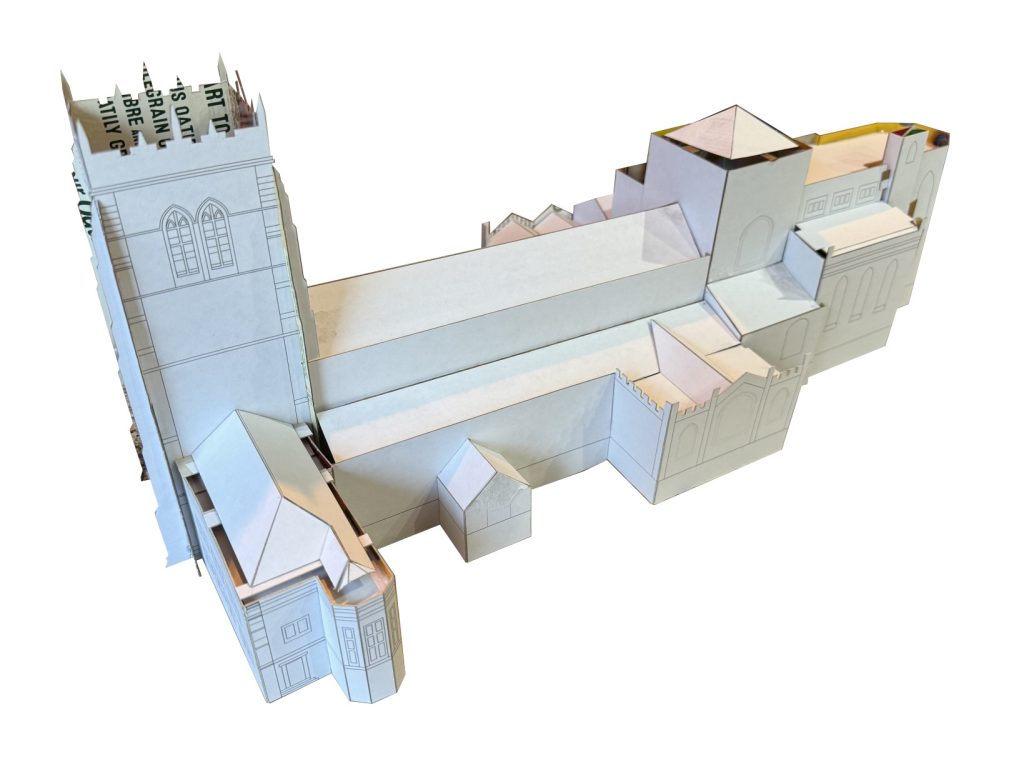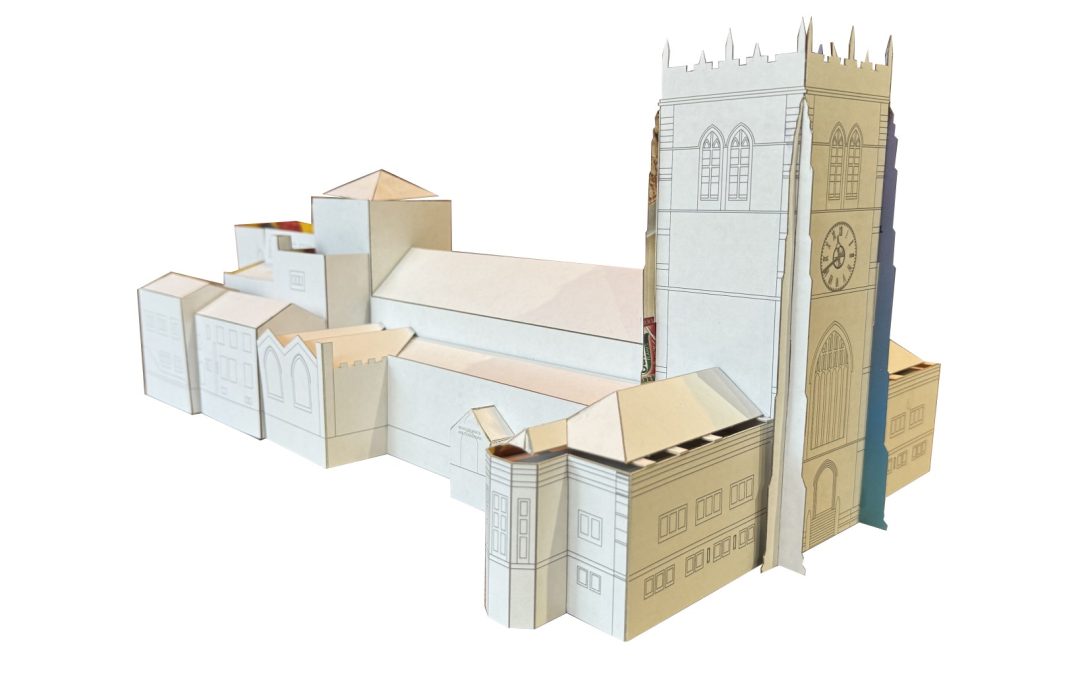On Saturday 14th September we are holding our next annual Heritage Open Day event, which will include guided tours, activities, stalls and much more. It will also see us welcoming Michael Scott to the Cathedral for a talk – ‘Smaller Scale, Wider Perspective: from miniature to marvel on a route less travelled’ – all about his work on his model town Chandwell and his creation of an accompanying model of Bradford Cathedral over the next twelve months.
Ahead of the event, we had a quick chat with Michael to found out more about all his work.
Could you introduce yourself and how the idea of ‘Chandwell’ began?
If you’ve ever seen one of my YouTube videos, you will know how they always begin – “My name’s Michael, and I’m building this model of a run-down West Yorkshire town, set in 1993”. But how did I get here, and where did I start?
While I was growing up in the 1980s, I was always captivated by my grandad’s N Gauge model railway and I would spend hours with him watching the trains go round and round and being inspired by the buildings, fields, roads and bridges. I found myself as a 40-something man reflecting on this sense of wonder, as well as the nostalgia of train travel as a teenager in the 1990s.
With some space set aside in my house, I set to building a layout. I’d intended to learn electronics and spend my spare time “playing trains”. But as soon as I started making buildings for my town, my outlook changed – this was the perfect way to express my creativity. I was as surprised as anyone to find out I was quite good at it!
Named using parts of my children’s names, “Chandwell” became a place to build in miniature some of the buildings that surround me, in and around Bradford.
Before I knew it, I had replicas of the Midland Hotel, the old Poor Law building (which became the Registry Office), the New Beehive pub. Shipley clock tower appeared. Sowerby Bridge town hall, the Crescent, and parts of Brook Street in Ilkley all became part of my fictional town.
As soon as I started weaving made up tales of the residents of Chandwell into my videos, the town took on a life of its own, and now, five years later, my YouTube channel is part story, part how-to, as we follow the journey to complete this model of a fictional town in Yorkshire.
What has been your favourite part of creating Chandwell?
Before I started making Chandwell, I would go around towns and cities without really looking at what was around me. A city was just a utility – a place to get stuff done, a route from A to B.
To make a model of a building, you have to really look a it. From top to bottom. How is it built? What holds it together? Notice the proportions of this bit, look at how that bit sticks out. Why did that bit get altered? When? Who by?
The more we look, the more we see. And what I found most interesting is that every building tells a story. Just look up in a city, especially Bradford, and marvel at the architecture above your head. It is beautiful and it is full of story and wonder.
This has changed my outlook for sure, and certainly altered how I see the built environment.
My most favourite part of building Chandwell has been the sense of community that has grown up around my YouTube channel. I have made real friends and I am enriched by the way people react to my silly stories. I am humbled by how people have become invested in my fictional, tongue-in-cheek look at West Yorkshire in 1993. I love sharing my model with an audience.
What is the most interesting thing you’ve discovered whilst doing it?
I discover interesting things with every model that I make: Bruce Forsyth opened Shipley Clock Tower in 1961; the shops at the bottom of Brook Street in Ilkley were the first purpose-built shops with accommodation above, in the town; you can still see the crest of the Midland Railway in the stonework of the Midland Hotel next to Forster Street station.
But the most interesting thing I have discovered is purely personal. As a lifelong “IT geek”, I had never considered myself as being creative. I have no musical talent, no artistic ability. But here I am, able to craft a tiny city and tell tales to an audience of 15,000. This has happened as if by accident, and I am bemused by how it transpired. I’m still an IT geek at heart but I’m forever grateful that Chandwell is here to help me switch off after a long day at work.

You are creating a model of Bradford Cathedral over the next 12 months. Could you tell us how that is progressing, and what stages you have been through so far?
When I said “yes” to building a model of the cathedral, I believed that this was not going to be too much of a challenge. The cathedral is quite small compared to some of the grander cathedrals in the country. It lacks the over-the-top gothic finery that would be so hard to make out of paper and card.
How wrong I was. This building is huge.
It will dwarf Station Road in Chandwell, and what I thought would be a 12-month part-time project will likely consume my every modelling hour for the next year.
The build is progressing well. I have spent many hours really looking at the cathedral in minute detail. I’ve watched videos, made measurements, read books, and really tried to get to know the building.
It’s taken me about 35 hours to break the building down into manageable sections, and draw them all out. I have ended up with 23 separate parts which will eventually glue together to make a whole. Each part is the size of a typical building on Chandwell.
I have completed the card mock-up, the maquette that helps prove the design. This is just cereal packets folded into shape and glued together, but it shows the size and scale of the model. It’s given me the confidence that I am on the right lines, and I am now ready to make the model for real.
I will be starting with section number Four – the nave. It’s almost 22cm long, 6cm wide, and stands almost 9cm tall: N scale is smaller than you might think.
What are the biggest challenges you’ve faced so far in creating the model?
The cathedral building is complex – it’s not a simple shape or size. It’s evolved over centuries, being modified over time. The biggest example of this is the 1950s extension by Sir Edward Maufe. This alone is about half of the overall complexity of the model.
The biggest challenge has been to work out how all these disparate sections fit together.
An interesting aspect of the cathedral is how it is built into the hillside. Stand at the bottom of the steps in front of the tower, and you’re over eight metres below the level of Stott Hill at the top of the hill. This level change adds a challenging aspect to working out the overall shape and dimensions of the model, and is perhaps the biggest challenge so far.
What are you most looking forward to as the creation continues?
I enjoy every aspect of the model-making process but what I love is when the model starts to really look like what I want it to. Adding the tiny bits of detail is my favourite task – stonework embellishments only one millimetre big make such a difference and really finish off a model.
I am looking forward to seeing the model emerge from the rough mock-up. I’m excited to see the nave with its tiled roof in place, the tower attach to the nave. Most of all I am looking forward to adding the completed model into its hillside. All I hope for is for someone to look at the completed model and think, “yes, that’s Bradford Cathedral”.
As part of the videos, you’re exploring the history of the building through pieces with our Director of Education and Visitors – what’s the most interesting thing you’ve discovered through these?
I am so lucky to have Maggie Myers involved with my videos. Maggie is a knowledgeable historian but that’s nothing compared to her ability to tell stories and weave the human connection into the heritage of the building around her.
I’ve discovered so much already. From how the tower was “plonked onto” the nave to how Maufe deliberately built the extension at a slight angle to the nave. I’ve learned about alterations made over the years, and the families who were instrumental in some of those changes. I’ve learned about wool sacks in the Civil War, and I’ve even learned something about why Bradford is called Bradford.
I’ll be sharing all of this and more in my videos over the year and I hope that some of Maggie’s infectious enthusiasm can help others be as enthused as I am with this wonderful project.
You are talking about the project at our upcoming Heritage Open Day. Could you tell us a little about the talk and what people can expect from it?
The theme of the Heritage Open Day this year is Routes, Networks, and Connections. I really don’t know if visitors will be interested in a railway modeller talking about his fictional town, but I want to make it more than that. I will be telling the story of Chandwell the model, Chandwell the place, and my personal route from shy IT geek to model-maker. I will be talking about the route I took, the connections I have made, how it all relates to Bradford, and how I ended up talking to an audience in its Cathedral.
What are your next steps for the project?
It’s time to start making the nave! I hope I can show progress on this at the Heritage Open Day, and start to appreciate what the completed model will look like.
How can people follow you online to find out more about the construction of the Cathedral, and your Chandwell work?
I post regular videos on my Chandwell YouTube channel.
You can join us on Saturday 14th September from 12noon – 3pm for our Heritage Open Day, where you can discover more about Chandwell and the creation of the Bradford Cathedral model. You can turn up on the day but booking is advised for the tours and talk, which can be done on our Eventbrite page.
The next video all about the creation of Bradford Cathedral will premiere soon.

